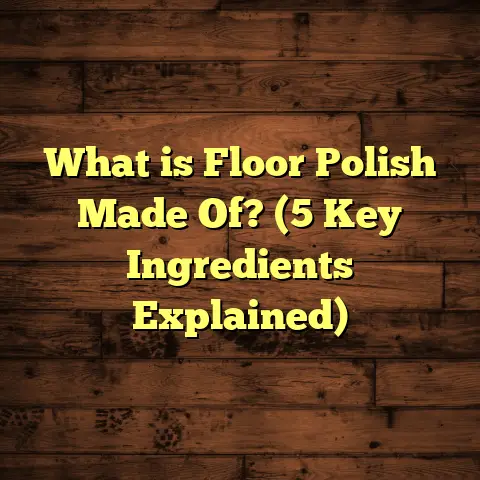What is Needed Under Marley Floor? (5 Essential Tips Revealed)
I remember the first time I took on a Marley flooring installation project. It seemed straightforward enough—lay the vinyl sheet down and secure it. But it quickly became clear that what happens beneath the surface plays a huge role in how the floor performs and looks over time. If you’re planning to install Marley flooring or just curious about what’s needed underneath, I’m happy to share what I’ve learned over years of hands-on experience.
Let me walk you through everything—from the basics of subfloor prep to choosing adhesives, moisture control, and how to plan for materials without breaking the bank. These five essential tips will help you avoid common mistakes and get professional-quality results.
What Is Needed Under Marley Floor?
Marley flooring is a type of vinyl sheet flooring known for its durability, ease of cleaning, and versatility in commercial and residential settings. But beneath that smooth, attractive surface lies a foundation that’s just as important.
So, what exactly is needed under Marley floor? At its core, a clean, flat, and stable subfloor is crucial. This surface acts as the groundwork for the vinyl sheet to adhere perfectly and maintain its integrity. Without a properly prepared subfloor, even the highest quality Marley vinyl can develop bubbles, cracks, or peel away prematurely.
Understanding Subfloor Types
Different types of subfloors require different preparation approaches. The most common subfloors you’ll encounter include:
- Concrete Slab: Often found in basements or ground-floor installations. Concrete can be rough or smooth but is prone to moisture issues.
- Plywood or OSB (Oriented Strand Board): Usually found in upper floors or wood-frame buildings.
- Existing Flooring: Sometimes Marley is installed over old flooring like tile or vinyl — but this can be tricky.
Knowing your subfloor type helps determine the prep steps. For example, concrete needs moisture testing and sealing, while plywood may require sanding and leveling.
Why Flatness Matters
One of the fundamental requirements for Marley flooring is a flat surface. I learned this the hard way early in my career when I installed Marley over a subfloor with minor bumps. The vinyl naturally mirrors every imperfection underneath. Even a dip or bump as small as 3mm (about 1/8 inch) can cause visible deformities once the floor is down.
To avoid this, I always check flatness using a long straight edge or laser level before installation. If uneven spots appear, I fill them with a self-leveling compound or sand down high points. This extra prep takes time but pays off by preventing costly repairs later.
Case Study: The Bumpy Basement Floor
I once worked on a basement renovation where the concrete slab was visibly uneven in some areas. The homeowner wanted Marley flooring for its waterproof qualities, but without addressing the subfloor issues first, the floor would have looked terrible after installation.
We applied a leveling compound across the entire floor and let it cure fully before laying down Marley. The result was a smooth finish with no bubbles or creases — a complete transformation from the original rough slab.
Moisture Control: The Silent Enemy Underneath
Moisture might not be obvious at first glance, but it’s one of the biggest threats to vinyl flooring longevity. Vinyl sheets like Marley are waterproof on top, but if water vapor seeps up from below through concrete or wood subfloors, it can cause blistering, adhesive failure, and mold growth.
How Moisture Affects Vinyl Floors
Vinyl flooring relies on adhesives to stick to the subfloor. When moisture comes through, it weakens these adhesives. You might start noticing bubbles forming under the vinyl or sections where the floor lifts up entirely.
In addition to adhesive problems, trapped moisture can lead to mold or mildew under your floor — not something you want lurking beneath your feet.
Testing for Moisture
Before starting any Marley installation on concrete slabs, I always test moisture levels with a moisture meter designed for flooring applications. The target moisture content should ideally be below 4-5%. If it’s higher than that, additional moisture mitigation steps are necessary.
For plywood or wood subfloors, visual inspection for rot or water damage is essential. Any soft spots should be repaired or replaced before installation.
Moisture Barriers and Sealers
If moisture levels are borderline or slightly high, applying a vapor barrier or moisture sealer can prevent problems. These barriers act as shields between the subfloor and adhesive layer.
I recall a project in an older home where the concrete slab was slightly damp due to ground water issues. We applied a liquid-applied vapor barrier, which bonded tightly to the concrete and allowed us to proceed with Marley installation safely.
Underlayments: Do You Need Them Under Marley Floors?
Unlike laminate or hardwood floors that almost always require underlayments for cushioning and soundproofing, Marley vinyl sheet floors generally don’t need thick underlayments. But that doesn’t mean underlayments aren’t useful at all.
Benefits of Thin Underlayments
For some installations—especially commercial spaces or areas over concrete—thin foam or cork underlayments can help reduce footstep noise and provide slight cushioning underfoot.
However, underlayments must be compatible with the adhesive system used for vinyl to prevent bond failure. Some adhesives do not work well over foam layers because they cannot penetrate sufficiently for a strong grip.
Personal Experience: When Underlayments Made a Difference
In one office space installation, sound reduction was critical as employees complained about noisy footsteps echoing in hallways. We installed a special thin cork underlayment approved for use with vinyl adhesives. The difference was noticeable immediately—less noise without compromising floor adhesion.
That said, for residential installations where noise isn’t a big concern, skipping underlayments altogether works fine if your subfloor is properly prepared.
Adhesives and Primers: The Glue That Holds It All Together
You might think that simply laying Marley vinyl on a clean floor is enough, but adhesives are what keep it firmly in place day after day.
Types of Adhesives
There are several types of adhesives commonly used with Marley flooring:
- Pressure Sensitive Adhesives (PSA): These allow repositioning during installation and form strong bonds once pressed.
- Acrylic-based Adhesives: Known for flexibility and good bond strength.
- Water-based Adhesives: Often environmentally friendly but may have slower curing times.
Choosing the right adhesive depends on factors like subfloor type, traffic level, and environmental conditions.
Using Primers
Primers prepare porous or dusty subfloors and enhance adhesion strength substantially. From my experience and manufacturer data, applying primer can increase adhesive bond strength by about 30%. This reduces risks of bubbling or peeling especially on concrete slabs that tend to release dust particles.
Skipping primer might save time upfront but leads to costly repairs later—trust me on this!
Matching Adhesives with Subfloors
I always check manufacturer guidelines to match adhesives with specific subfloor types and Marley vinyl products. Mixing incompatible products sometimes results in poor performance.
For example, older concrete slabs might require primers plus acrylic adhesives; plywood generally works well with PSAs directly applied.
Planning Materials and Cost Estimation: Avoid Surprises Using Smart Tools
Ordering too much flooring material is wasteful; too little means delays mid-project. Getting your material estimation right is critical.
Why Waste Factor Matters
When cutting Marley flooring around corners or odd shapes, some waste is inevitable. Typically, I add 5-10% extra material for waste during planning—more if rooms have complex layouts.
How I Use Tools Like FloorTally
I rely on FloorTally to handle these calculations efficiently. By inputting room dimensions and material choices, it automatically calculates total square footage needed including waste factor. Plus, it provides local pricing estimates for materials and labor based on my location.
This helps me budget better and avoid last-minute emergencies buying extra rolls or underestimating labor costs.
Real-World Example: Budgeting Made Easy
On a recent commercial project covering 1,200 sq ft with Marley flooring on concrete subflooring, FloorTally helped me forecast:
- 1,320 sq ft of vinyl material (including 10% waste)
- Adhesive required based on manufacturer coverage rates
- Labor hours based on crew size and project complexity
- Total cost projections matching actual expenses within 5%
Having these numbers beforehand gave my client confidence and kept everything on track financially.
Addressing Common Problems Underneath Marley Flooring
Even with careful preparation, sometimes issues arise after installation. Here’s how I handle typical problems related to what’s underneath:
Bubbles and Blisters
Usually caused by trapped air or moisture vapor pushing up through the adhesive layer. Checking moisture beforehand reduces this risk dramatically.
If bubbles appear later, sometimes heating the area gently with a heat gun while pressing down can flatten them temporarily—but permanent fixes often require lifting the affected sheet portion and re-gluing after drying out moisture sources.
Cracking or Peeling Edges
Often due to poor adhesion from dusty or porous subfloors without primer or using incompatible adhesives.
Always clean subfloors thoroughly before installation and test adhesion by applying small patches first if uncertain.
Uneven Surface Appearance
If you notice ripples or uneven texture visually after installation, revisit your flatness checks. Sanding high spots or filling dips before installation avoids this problem entirely.
Specialized Tips From My Experience
Here are some lesser-known tips I’ve picked up that helped me avoid headaches:
- Always acclimate Marley vinyl sheets in the installation room for 24-48 hours beforehand to adjust to temperature changes.
- Clean subfloors with tack cloths multiple times before applying adhesive.
- Use knee pads and proper tools when smoothing down vinyl to avoid fingerprints or indentations.
- When working in humid climates, increase ventilation during installation to speed drying times.
- Label vinyl sheets carefully if using multiple rolls to maintain pattern consistency.
Wrapping Up My Five Essential Tips for What Goes Under Marley Flooring
Let’s recap:
- Subfloor Prep: Flatness within 3mm tolerance is key—use leveling compounds as needed.
- Moisture Testing: Always measure moisture levels; apply vapor barriers if above recommended thresholds.
- Underlayments: Optional but beneficial for soundproofing—ensure compatibility with adhesives.
- Adhesives & Primers: Choose right adhesive type; use primers on porous surfaces for stronger bonds.
- Material Planning: Incorporate waste factor; leverage tools like FloorTally for accurate cost estimation.
These tips stem from countless projects where attention to detail beneath the surface made all the difference between floors that look great for years versus those needing early repair.
If you’re ready to install Marley flooring yourself or hire professionals, focusing on these foundation steps will save you time, money, and stress down the road.
Want me to break down any section further? Or help you troubleshoot specific challenges you’re facing? Just ask!





